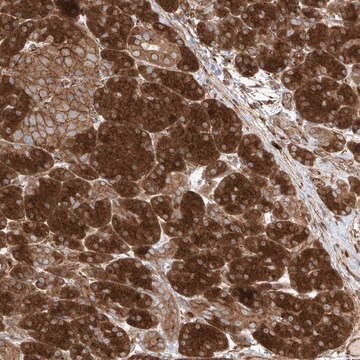About This Item
Código UNSPSC:
12352200
NACRES:
NA.32
Produtos recomendados
capacidade
0.2 mg loading(0.2 mg D-Ribulose 1,5-Diphosphate Carboxylase (Rubisco))
temperatura de armazenamento
2-8°C
Procurando produtos similares? Visita Guia de comparação de produtos
Descrição geral
RuBisCO (Ribulose-1,5-bisphosphate carboxylase/oxygenase) is the most abundant protein in plants, and it may be the most abundant protein on Earth. RuBisCO is an enzyme that is used in the Calvin cycle to catalyze the first major step of carbon fixation, a process by which the atoms of atmospheric carbon dioxide are made available to organisms in the form of energy-rich molecules such as sucrose. RuBisCO, while being the key enzyme in photosynthetic carbon assimilation in green leaves, is the main obstacle in plant proteomics. It constitutes about 40% of the total protein mass in green leaves, thus interfering with proteomics studies such as LC-MS/MS and 2D-gel electrophoresis. To meet the needs for specifically and effectively separating RuBisCO from other plant proteins, Sigma developed a novel immunoaffinity matrix based on the IgY antibodies cross-linked to microbeads, which specifically removes RuBisCO protein from plant extract.
Aplicação
Seppro® Rubisco, spin columns (capacity: ∼0.2 mg of Rubisco) may be used in plant proteomics research to effect IgY-mediated immune affinity removal of RuBisCO (Ribulose-1,5-bisphosphate carboxylase/oxygenase) from plant tissue extracts via liquid chromatography.
Informações legais
Seppro is a registered trademark of Merck KGaA, Darmstadt, Germany
Componentes do kit também disponíveis separadamente
Nº do produto
Descrição
SDS
Código de classe de armazenamento
10 - Combustible liquids
Escolha uma das versões mais recentes:
Já possui este produto?
Encontre a documentação dos produtos que você adquiriu recentemente na biblioteca de documentos.
Os clientes também visualizaram
Martin Černý et al.
Journal of experimental botany, 64(14), 4193-4206 (2013-09-26)
In plants, numerous developmental processes are controlled by cytokinin (CK) levels and their ratios to levels of other hormones. While molecular mechanisms underlying the regulatory roles of CKs have been intensely researched, proteomic and metabolomic responses to CK deficiency are
Ankita Sehrawat et al.
Frontiers in plant science, 4, 342-342 (2013-09-14)
Although in the last few years good number of S-nitrosylated proteins are identified but information on endogenous targets is still limiting. Therefore, an attempt is made to decipher NO signaling in cold treated Brassica juncea seedlings. Treatment of seedlings with
The Nucleolar Fibrillarin Protein Is Required for Helper Virus-Independent Long-Distance Trafficking of a Subviral Satellite RNA in Plants
Chang CH, et al.
Plant Cell (2016)
Renato Millioni et al.
PloS one, 6(5), e19603-e19603 (2011-05-17)
To date, the complexity of the plasma proteome exceeds the analytical capacity of conventional approaches to isolate lower abundance proteins that may prove to be informative biomarkers. Only complex multistep separation strategies have been able to detect a substantial number
Shasha Zhou et al.
Plant science : an international journal of experimental plant biology, 236, 44-60 (2015-05-31)
Water use efficiency is an important indicator for plant adaptation and resistance to drought conditions. We previously found that under moderate drought stress, the water use efficiency of cv. 'Qinguan' apple (Malus domestica Borkh.) (tolerant to drought) was enhanced, while
Nossa equipe de cientistas tem experiência em todas as áreas de pesquisa, incluindo Life Sciences, ciência de materiais, síntese química, cromatografia, química analítica e muitas outras.
Entre em contato com a assistência técnica










